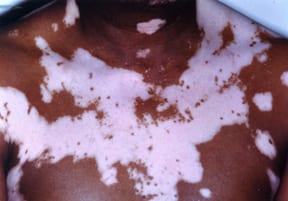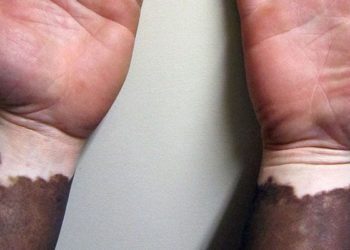Patient Basics: Vitiligo
Originally published by Harvard Health.
What Is It?
Vitiligo consists of white patches of skin that are caused by the loss of melanin, the pigment that gives skin its color. Melanin is produced by special cells called melanocytes, which are destroyed in people who have vitiligo. Experts are still working out the details to understand why this disease occurs, but evidence strongly suggests that vitiligo is an autoimmune disorder, in which the body’s immune system mistakenly targets and injures these specific cells within your own body.
Vitiligo can cause minor changes or extensive changes in the skin. In some people, it may be hardly noticeable, while in others it is obvious. In dark-skinned people the vitiligo patches are obvious since they contrast with normal skin. Light-skinned people may have fewer cosmetic concerns, but patches without pigment can become obvious in the summer because unaffected skin tans but vitiligo skin does not tan.
Vitiligo occurs in about 1 percent to 2 percent of the population. Approximately 30 percent of people with vitiligo have a family history of the condition. About half of people with vitiligo start showing symptoms before age 20.
People with vitiligo have an increased risk of developing certain diseases, such as hypothyroidism (an underactive thyroid), hyperthyroidism (an overactive thyroid), type 1 diabetes, Addison’s disease (a disease that causes a decrease in the function of the adrenal gland) and pernicious anemia (vitamin B12 deficiency). Also, people with these conditions have an increased risk of developing vitiligo. These medical conditions are all problems that involve the immune system attacking cells in the body.
Symptoms
Vitiligo causes patches of white skin that are often symmetrical (even), with dark or red borders. The patches can occur anywhere, but the areas most commonly affected are the backs of the hands, the face, and areas that have skin folds, such as the armpits and genitals. Body openings, such as the lips, eyes, nipples and anus are also common areas for vitiligo, as are areas that have been sunburned.
Vitiligo can occur in bursts, so that sizeable areas of skin may rapidly lose their pigment during the beginning stages of the condition, yet then these whitened skin patches may abruptly stop expanding for months or years.
Diagnosis
Vitiligo causes a pattern of skin changes that usually can be recognized easily by a doctor. If the skin changes are in a pattern that suggests other conditions, your doctor might recommend a biopsy of the skin to be certain about your diagnosis. In a biopsy, a small piece of skin is removed and examined in a laboratory. A biopsy usually is not needed to diagnose vitiligo.
Expected Duration
In 1 out of every 5 to 10 people, some or all of the pigment eventually returns on its own and the white patches disappear. For most people, however, the whitened skin patches last and grow larger if vitiligo is not treated. Vitiligo is a lifelong condition.
Prevention
There is no way to prevent vitiligo.
Treatment
Vitiligo is difficult to treat, and responses vary. The most important treatment is to protect areas of vitiligo from the sun. It is very easy for areas without pigment to become sun-burned. This increases the risk of skin cancer. Wear sun-protective clothing and/or apply sunscreen with a sun protection factor (SPF) of at least 30 to areas affected by vitiligo.
Other treatments can be attempted if vitiligo causes emotional or social distress. The goals of treatment are to minimize the contrast in color between your normal skin and skin patches that have lost pigment.
- If you are light-skinned, part of your treatment may be to protect your normal skin from tanning by using sunscreens with a sun protection factor (SPF) of at least 30.
- Topical treatments are can be helpful in some people. These are applied directly to the skin. Steroid creams or ointments are applied once a day for up to several months. These medications are not always effective, and they can thin the skin with continued use. Other medicines that may be helpful include tacrolimus (Protopic) and pimecrolimus (Elidel), but these medicines are used with caution because of a possible link between these drugs and skin cancer or lymphoma.
- Ultraviolet B light treatment can be effective for treating vitiligo in many patients. Ultraviolet light can be provided by a hand-held light box for smaller areas of skin. People who have many areas of skin involved can be treated by putting on goggles and standing inside a closet-sized light box for several minutes. The treatment must be repeated often, usually for three times a week and for at least six months. Side effects, which should be discussed thoroughly with your dermatologist, include itching, pain and sunburn as well as increased risk of skin cancers.
- Psoralen plus ultraviolet A light treatment (commonly called PUVA) causes slightly more pronounced side effects than ultraviolet B light therapy, but it is another effective way to treat vitiligo. Psoralens are drugs that cause skin to darken when they react with ultraviolet A light. They can be applied as a cream or taken as pills. After the psoralen medicine is used, you are exposed to ultraviolet light. PUVA treatment is not for pregnant women, women who are breastfeeding or children younger than 10. There is also an increased risk of skin cancers.
- Oral medicines that suppress your immune system can sometimes allow normal pigment to return. For people who have large skin areas involved, oral steroids sometimes are used instead of steroids applied to the skin. This treatment is seldom used because of potential side effects of oral steroids.
- For people with severe vitiligo, depigmentation can remove the color from normal skin, making all of the skin the same white color. This treatment is rarely used because the skin without pigment is very vulnerable to damage from sun exposure. A bleaching solution is applied daily for up to 12 months. It may be two or three months before you see any effects. About 95 percent of people will be depigmented within 12 months, and must then meticulously avoid sun exposure. Side effects can occur in up to 50 percent of those treated, and include skin redness, dryness, itching and burning, especially on the face.
- Skin grafting removes normal skin from less visible areas and uses this skin to replace white areas in places where the person has the most cosmetic concerns. Skin grafting is used only in a very small number of people with vitiligo.
When To Call a Professional
If you notice that patches of skin appear white, contact your doctor for an examination. Treatment may be most helpful if it can be started when only a small area of skin is affected. It is very important to wear sunscreen to protect the areas affected by vitiligo, since these areas are especially at risk for sunburn and for skin cancers.
Prognosis
For most people with vitiligo, this condition slowly worsens without treatment or needs continued treatment.
Additional Info
American Academy of Dermatology
P.O. Box 4014
Schaumburg, IL 60168-4014
Phone: 847-330-0230
Toll-Free: 1-888-462-3376
Fax: 847-330-0050
http://www.aad.org/









